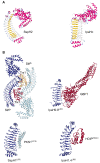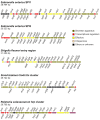The NEL Family of Bacterial E3 Ubiquitin Ligases
- PMID: 35887072
- PMCID: PMC9320238
- DOI: 10.3390/ijms23147725
The NEL Family of Bacterial E3 Ubiquitin Ligases
Abstract
Some pathogenic or symbiotic Gram-negative bacteria can manipulate the ubiquitination system of the eukaryotic host cell using a variety of strategies. Members of the genera Salmonella, Shigella, Sinorhizobium, and Ralstonia, among others, express E3 ubiquitin ligases that belong to the NEL family. These bacteria use type III secretion systems to translocate these proteins into host cells, where they will find their targets. In this review, we first introduce type III secretion systems and the ubiquitination process and consider the various ways bacteria use to alter the ubiquitin ligation machinery. We then focus on the members of the NEL family, their expression, translocation, and subcellular localization in the host cell, and we review what is known about the structure of these proteins, their function in virulence or symbiosis, and their specific targets.
Keywords: E3 ubiquitin ligases; Ralstonia; Salmonella; Shigella; Sinorhizobium; effectors; type III secretion.
Conflict of interest statement
The authors declare no conflict of interest. The funders had no role in the design of the study; in the collection, analyses, or interpretation of data; in the writing of the manuscript, or in the decision to publish the results.
Figures




Similar articles
-
Specificities and redundancies in the NEL family of bacterial E3 ubiquitin ligases of Salmonella enterica serovar Typhimurium.Front Immunol. 2024 Feb 1;15:1328707. doi: 10.3389/fimmu.2024.1328707. eCollection 2024. Front Immunol. 2024. PMID: 38361917 Free PMC article.
-
Revisiting Bacterial Ubiquitin Ligase Effectors: Weapons for Host Exploitation.Int J Mol Sci. 2018 Nov 13;19(11):3576. doi: 10.3390/ijms19113576. Int J Mol Sci. 2018. PMID: 30428531 Free PMC article. Review.
-
Mechanism of catalysis, E2 recognition, and autoinhibition for the IpaH family of bacterial E3 ubiquitin ligases.Proc Natl Acad Sci U S A. 2017 Feb 7;114(6):1311-1316. doi: 10.1073/pnas.1611595114. Epub 2017 Jan 23. Proc Natl Acad Sci U S A. 2017. PMID: 28115697 Free PMC article.
-
Bacterial E3 ligase effectors exploit host ubiquitin systems.Curr Opin Microbiol. 2017 Feb;35:16-22. doi: 10.1016/j.mib.2016.11.001. Epub 2016 Nov 28. Curr Opin Microbiol. 2017. PMID: 27907841 Review.
-
Hijacking the host ubiquitin pathway: structural strategies of bacterial E3 ubiquitin ligases.Curr Opin Microbiol. 2010 Feb;13(1):41-6. doi: 10.1016/j.mib.2009.11.008. Epub 2009 Dec 28. Curr Opin Microbiol. 2010. PMID: 20036613 Free PMC article. Review.
Cited by
-
Tracking of Ubiquitin Signaling through 3.5 Billion Years of Combinatorial Conjugation.Int J Mol Sci. 2024 Aug 8;25(16):8671. doi: 10.3390/ijms25168671. Int J Mol Sci. 2024. PMID: 39201358 Free PMC article. Review.
-
Immune evasion and persistence in enteric bacterial pathogens.Gut Microbes. 2023 Jan-Dec;15(1):2163839. doi: 10.1080/19490976.2022.2163839. Gut Microbes. 2023. PMID: 36617629 Free PMC article.
-
The Shigella flexneri effector IpaH1.4 facilitates RNF213 degradation and protects cytosolic bacteria against interferon-induced ubiquitylation.bioRxiv [Preprint]. 2024 Sep 5:2024.09.05.611450. doi: 10.1101/2024.09.05.611450. bioRxiv. 2024. PMID: 39282383 Free PMC article. Preprint.
-
Ehrlichia chaffeensis TRP120 ubiquitinates tumor suppressor APC to modulate Hippo and Wnt signaling.Front Cell Dev Biol. 2024 Mar 18;12:1327418. doi: 10.3389/fcell.2024.1327418. eCollection 2024. Front Cell Dev Biol. 2024. PMID: 38562145 Free PMC article.
-
Host-Pathogen Interaction 5.0.Int J Mol Sci. 2024 Dec 19;25(24):13596. doi: 10.3390/ijms252413596. Int J Mol Sci. 2024. PMID: 39769357 Free PMC article.
References
Publication types
MeSH terms
Substances
Grants and funding
- PID2019-106132RB-I00/AEI/10.13039/501100011033/Ministerio de Ciencia e Innovación - Agencia Estatal de Investigación
- P20_00576/Fondo Europeo de Desarrollo Regional (FEDER) y Consejería de Transformación Económica, Industria, Conocimiento y Universidades de la Junta de Andalucía
- US-1380805/Universidad de Sevilla, Fondo Europeo de Desarrollo Regional (FEDER) y Consejería de Transformación Económica, Industria, Conocimiento y Universidades de la Junta de Andalucía
LinkOut - more resources
Full Text Sources

